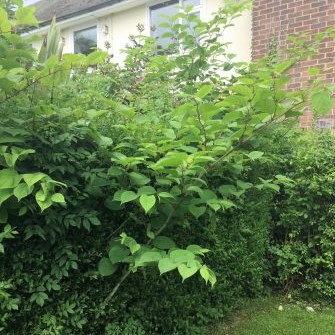 Estate agents are all too aware of the potential problems caused by invasive plant species such as Japanese Knotweed, with a number of property sales collapsing over the years as a consequence of the much-feared visitor to our gardens.
Estate agents are all too aware of the potential problems caused by invasive plant species such as Japanese Knotweed, with a number of property sales collapsing over the years as a consequence of the much-feared visitor to our gardens.
With concerned homeowners, gardeners, and agents on high alert, it is not uncommon for other garden plants such as bindweed, dogwood and lilac for to be mistaken for highly invasive Japanese knotweed, according to new research.
Analysis of data from Environet’s Free ID Service, which invites members of the public to send in a photo of any suspicious plants in their garden for expert identification, has shown that bindweed is by far the plant most commonly confused with knotweed, accounting for one in four (26%) of all the photos received. Knotweed was identified correctly in just 16% of cases.
Bindweed shares a number of characteristics with knotweed, including rapid growth and vivid green heart-shaped leaves, but the key difference is that while knotweed is self-supporting, bindweed needs to wrap itself around other plants, walls or structures. When it comes into flower, bindweed has large, trumpet-shaped flowers while the small cream-white flowers of knotweed, appearing only in late summer, grow in dangling clusters. Whilst a nuisance, bindweed has no capacity to cause damage to property.
Dogwood, meanwhile, which accounted for 9% of the photos sent in for identification during 2023, is a woody shrub with bright red stems. It is easily mistaken for knotweed, the stems of which are flecked or tinted with red during the growing season.
Other plants commonly confused with knotweed include lilac, Russian vine, dock, buddleia, bamboo, Himalayan balsam and even common ivy, which is found in most British gardens. At this time of year, when new growth begins, the red shoots of knotweed also look very similar to peony.
Failure to identify and treat Japanese knotweed as soon as it appears will result in it spreading and quickly becoming established.
Knotweed has the power to damage buildings, sheds, walls, patios, as well as underground services such as pipes and drains. Mortgage lenders will offer loans on affected properties, but only if a professional treatment plan is in place with an insurance-backed guarantee. Knotweed can also leave homeowners at risk of litigation from neighbours if they allow it to spread from their garden into an adjoining property.
Despite the fact that people struggle to recognise knotweed by sight, general awareness is high, with a YouGov survey undertaken in 2023 indicating that 77% of people in the UK have heard of the plant. Awareness is highest amongst the 55+ age group (92%) and, geographically, in areas where the spread of knotweed has been most prolific according to Environet’s live Japanese Knotweed Heatmap, such as the South West (87%), Wales (84%) and the Midlands (80%).
Environet director, Emily Grant, said, “While most people have heard of Japanese knotweed, identifying it correctly is another matter. Very soon, when the ground temperature begins to rise in March or April, knotweed will emerge from the ground and by early summer it will be growing rapidly – in some cases as much as 10cm every day. The longer it’s left, the further its underground root system will spread and the more it will cost to remove.
“The best way to protect your property is to research knotweed identification online and be vigilant, particularly if a new plant appears this spring that you don’t recall seeing before. Those buying and selling property should also carry out thorough checks or commission a professional survey for complete peace of mind.”
How to identify Japanese knotweed
+ In early spring, when the ground begins to warm up, reddish-purple spear-like shoots emerge and grow rapidly, forming canes. Heart-shaped leaves unfurl and turn green.
+ Between May and July, knotweed grows rapidly, supported by hard, bamboo-like hollow canes with a distinctive purple speckle. Green leaves grow in a zig-zag formation along the stem. Mature plants form dense stands up to 3 metres high, covered in clusters of cream-white flowers from late summer.
+ In autumn, the leaves fall turn yellow, then brown, and eventually fall to the ground. The canes lose their fleshy green appearance, turning brown and brittle.
+ During winter, all that remains are the dead canes which remain standing, and the plant’s distinctive crowns – a woody mass of rhizome which is usually visible in the ground.


Comments are closed.